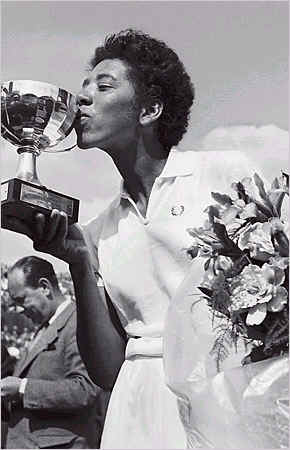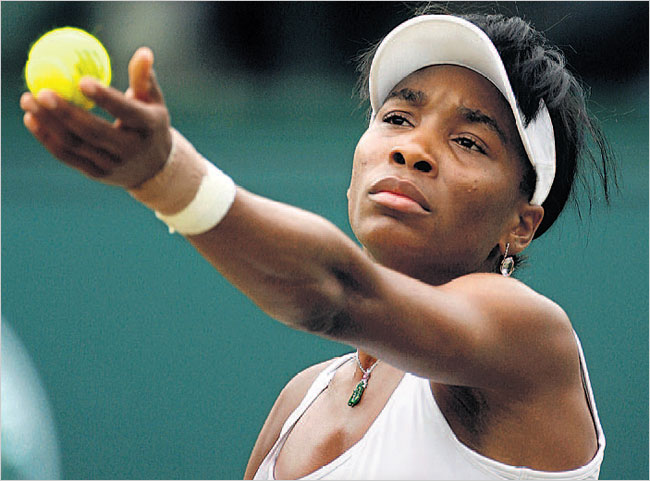| Want to send this page or a link to a
friend? Click on mail at the top of this window. |
| Tennis Nonwhites |
| _______________________________________________ |
|
|
| A history of black players, and an
autobiography by one who's still competing at the game's highest levels. |
|
|
| CHANGING THE NET |
| A History of Blacks in Tennis |
| From Althea Gibson and Arthur Ashe |
| to the Williams Sisters. |
| By Cecil Harris and Larryette Kyle-De-Bose. |
| Illustrated. 267 pp. Ivan R. Dee. $26.95 |
|
|
| By TOURÉ |
FROM the start of their
professional tennis careers, Venus and Serena Williams seemed totally certain they were
champions; they marched through the tennis world with the ferocity of the young Mike
Tyson. James Blake was No. 9 in the world at the conclusion of Wimbledon this month; late
last year he was No. 4. But only twice in his career has he reached a Grand Slam
quarterfinal, and many have long sensed that his potential has been limited because he
doesn’t truly believe he belongs in big-time tennis. He’s cursed with the
unsureness of Dave Chappelle. Blake confirms this in his memoir, “Breaking Back”
(written with Andrew Friedman), when, early in his career, he drops a winnable match to
the great Patrick Rafter. “After the match, as we shook hands at the net, he leaned
in close, the zinc oxide he smeared under his eyes like war paint runny with sweat:
‘You could have beaten me today,’ he said, surprising me, ‘but I had the
sense that maybe you didn’t believe it yourself.’ He paused, then said,
‘Now do you believe?’ ... He perceived something about me that I wasn’t
even admitting to myself: I didn’t really believe that I belonged out there with the
best players in the world. I didn’t feel like I deserved to win.”
 |
Bettman/Corbis |
| Althea Gibson won the French Open in 1956, above, and 10 other major
titles in the 1950s, but ended broke, reclusive and bitter. |
Back” is about more than tennis and race. That’s because Blake, like Ashe, is
smarter and deeper than most athletes, and also because in 2004 Blake lived his own year
of magical thinking. First, in a freak accident on a wet clay court in Rome, as he ran for
a drop shot he tripped and flew headfirst toward the net post. He turned his head at the
last second and dodged paralysis by inches, crashing into the steel pole with his neck.
“I wanted to do a quick analysis of the situation, but my mind was whirring much too
quickly. I was strangely disconnected from the world around me, in a place beyond pain and
discomfort. I hadn’t quite blacked out, but my eyes were closed and the darkness was
comforting, transporting. Deep down, almost subconsciously, I was aware that I had just
suffered a serious injury, and that once I opened my eyes, there was a terrible reality to
be confronted. So I lingered in the darkness, putting off the inevitable for just a few
seconds.” His neck broken, Blake returned to his hometown in Connecticut to spend
time with his father, who was dying of stomach cancer. After his death, Blake developed
zoster (shingles), which paralyzed the left side of his face. He ended up going back to
tennis’s minor leagues, the Challenger Series, to get his career going again. Soon he
was back in the majors, with more confidence and maturity. Valiantly he took Andre Agassi
to a fifth-set tie breaker in the quarters of the United States Open in 2005. Blake lost
that winnable match, but he was able to force a fifth-set breaker, he says, because of
what he had gleaned from his travails. He didn’t get down on himself when bad things
happened on the court, because he remembered his father’s strength and also because
he embraced something Pete Sampras had told him: “You have to have a short
memory.” You have to have the in-game amnesia that all athletes need to thrive. Now
that Blake is developing it, maybe he’ll finally win a Slam.
The problem with memoirs by active athletes is that guys still in the locker room feel
bound to keep that world a secret, and Blake is no different. I longed for a few stories
from behind the scenes about Andy Roddick, Rafael Nadal, even that rascal Vince Spadea,
but no. Blake says: “The ATP Tour is like a kind of traveling neverland, where no one
forces you to grow up. So a lot of the guys are indistinguishable from overgrown
adolescents.” But he never elaborates. Early in his career, during a tough match at
the United States Open, his opponent, Lleyton Hewitt, suggested that a black linesman was
making calls in favor of Blake because of their shared race. I was hoping for a fuller
story from Blake, but no.
| The unspoken but persistent
view that the're not welcome is 'a vibe that black tennis players have sensed for
decades.' |
Curiously, Blake gives the slightly fuller telling of that story to Cecil Harris and
Larryette Kyle-DeBose for their history of black tennis, “Charging the Net.”
Blake tells them: “We talked about it in the locker room, and he did apologize. ...
He said he didn’t mean for it to come out the way it did. ... I knew we would both be
on the tour for a long time, and I told him that if he said anything like that again, I
wouldn’t be so kind.”
“Charging the Net” is a wide-ranging history, built on more than 65
interviews, that tells in-depth stories about the lives of black tennis stars like Venus
and Serena; Arthur Ashe; Althea Gibson, the Wimbledon champ from Harlem who ended up
broke, reclusive and bitter; and Zina Garrison, the Wimbledon finalist who, during her
career, was dragged down by bulimia and a husband who, she says, encouraged her to stay on
the tour so he could continue his affair with one of her friends. The authors cover the
tennis diaspora, discussing famous umpires like Cecil Hollins, who feels he was kept from
advancement by racism; legendary coaches like Dr. Robert Johnson, who molded Ashe; and the
French stars Yannick Noah and Gael Monfils. There are some strange choices — they
barely mention two Africans now on the tour, Hicham Arazi and Younes el-Aynaoui, both from
Morocco, but give several pages to the Wimbledon winner Evonne Goolagong, an Australian
aborigine. Aborigines may be oppressed and darker-skinned, but does that make them black?
The original Australians are no blacker than, say, Vijay Amritraj of India, who played in
the ’70s and ’80s and acted opposite Roger Moore in “Octopussy.” Alas,
he’s not in the book. The authors claim that a black man named Edgar Brown “is
credited by some with introducing topspin” around 1900. The International Tennis Hall
of Fame and serious tennis historians recognize Herbert Lawford, Wimbledon champ in 1887,
as the introducer of topspin, but maybe they’re just racist.
 |
Tobis Melville/Reuters |
| Venus William |
Whereas Blake glosses over the subject of race, Harris, a sportswriter, and
Kyle-DeBose, an author and photojournalist, make racism a recurring theme, arguing that it
has dealt a devastating blow to black tennis dreams. They write, “The unspoken but
persistent vibe that you are not welcome, that others would be happier if you went away, a
vibe that black tennis players have sensed on the main tour for decades, makes it
difficult to find the rhythm and comfort zone needed to perform at your best.” Leslie
Allen, who played on the women’s tour in the ’80s, when players frequently
stayed with host families rather than in hotels, says housing was often hard to find:
“I’d go to a tournament where the family wanted to house the No. 1 seed. But
when that family found out that the No. 1 seed was me, then suddenly the housing
disappeared.” The great coach John Wilkerson, who taught Garrison, says black players
(in the authors’ words) “have not won more major championships because too many
of them believe deep down that they don’t belong in the sport.” Apparently, the
feeling that’s held Blake back has held back many. Touré is the author of
“Never Drank the Kool-Aid.” He was once ranked No. 1 in the men’s division
of the American Tennis Association. Next Article in Books (3 of 15) »Need to know more?
50% off home delivery of The Times. Ads by Googlewhat's this?
Copyright 2007 The New York Times Company. Reprinted from The New York Times, Book
Review, of Sunday, July 22, 2007.
| Wehaitians.com, the scholarly journal of
democracy and human rights |

